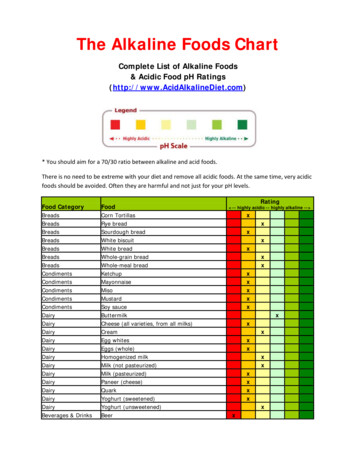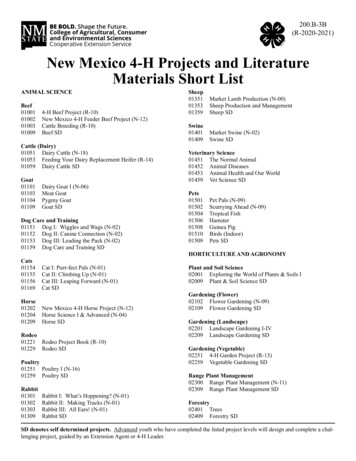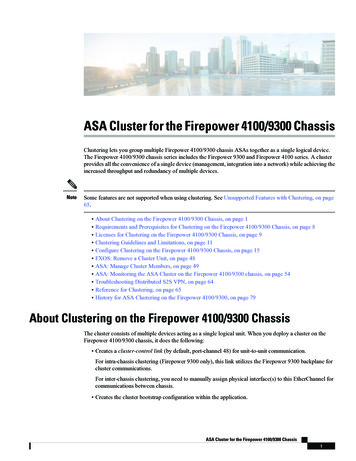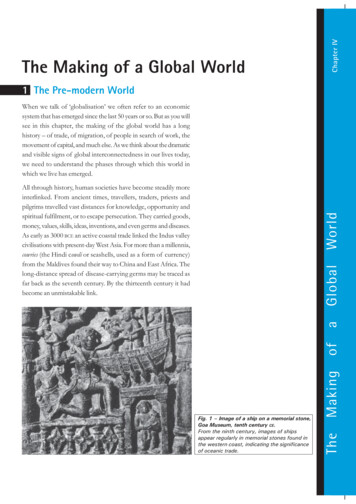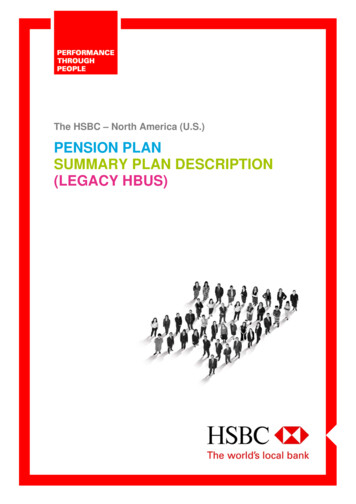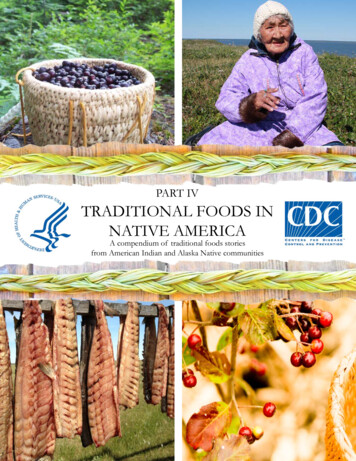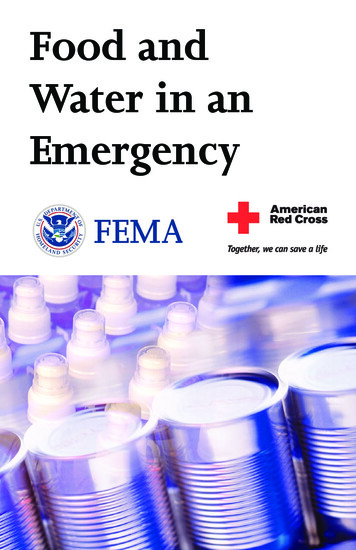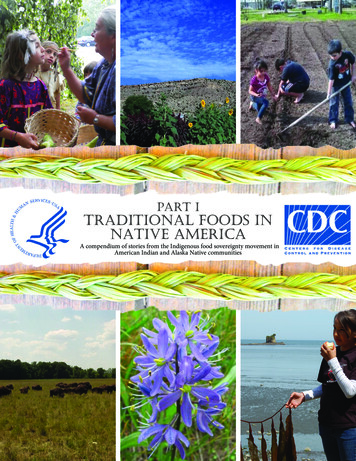
Transcription
Part ItradItIonal Foods InnatIve amerIcaA compendium of stories from the Indigenous food sovereignty movement inAmerican Indian and Alaska Native communities
“Food is at the center of our culture. it feeds our bodies and it feeds our spirit.”Vanessa Cooper (Lummi)Northwest Indian College - Traditional Plants & Food Program
AcknowledgementsThe Native Diabetes Wellness Program expresses gratitude and thanks to Chelsea Wesner (Choctaw), AmericanIndian Institute, University of Oklahoma, who collected the interviews that inspired this report. Ms. Wesnerwrote the report in collaboration with the National Indian Health Board and the Native Diabetes WellnessProgram.All collaborators would especially like to thank staff and tribal members from the programs featured:Mohegan Foodways (Mohegan Tribe), Mvskoke Food Sovereignty Initiative (Muscogee (Creek) Nation), OneidaCommunity Integrated Food Systems (Oneida Nation), Seven Arrows Garden (Pueblo of Laguna), SuquamishCommunity Health Program (Suquamish Tribe), and the Traditional Plants & Food Program (Northwest IndianCollege). This report would not have been possible without the sharing of their stories and diverse experience inrestoring traditional food systems.Suggested citation: Centers for Disease Control and Prevention. (2013). Traditional Foods in Native America: ACompendium of Stories from the Indigenous Food Sovereignty Movement in American Indian and AlaskaNative Communities—Part I. Atlanta, GA: Native Diabetes Wellness Program, Centers for Disease Control &Prevention.1
tAble of contents3Purpose and Background3Traditional Foods Programs and Food Security4Methods4Key Findings and Shared ThemesfeAtured trAditionAl foods ProgrAms: PAges 6-316Mohegan Foodways - Mohegan Tribe12Mvskoke Food Sovereignty Initiative (MFSI) - Muscogee (Creek) Nation17Oneida Community Integrated Food Systems (OCIFS) - Oneida Nation of Wisconsin21Seven Arrows Garden - Pueblo of Laguna26Suquamish Community Health Program - Suquamish Tribe29Traditional Plants & Food Program - Northwest Indian College (NWIC)trAditionAl foods reciPes: PAges 32 - 4233Recipes from the Oneida Nation of Wisconsin36Recipes from the Suquamish Tribe38Recipes from the Muscogee (Creek) Nation43Contact Information44Additional Resources45References
PurPose And bAckgroundCommissioned by the Centers for Disease Control andPrevention’s (CDC) Native Diabetes Wellness Program(NDWP), this report highlights traditional foodsprograms in six culturally and geographically diverseAmerican Indian and Alaska Native communities. Fordecades, American Indian and Alaska Nativecommunities have been reclaiming traditional foodsand practices as an integral part of the Indigenous foodsovereignty movement, which embraces identity andhistory, tribal sovereignty, traditional ways and culturalpractices to address health.For more than a decade, the CDC’s NDWP hassupported tribally driven efforts to promote health andhelp prevent type 2 diabetes in American Indian andAlaska Native communities. Among manypromising efforts, such as the highly acclaimed EagleBooks series and the Diabetes Education inTribal Schools K-12 Curriculum (DETS), a particularlyinnovative approach to diabetes prevention has beenthe Traditional Foods Program. Supporting theIndigenous food sovereignty movement to reclaimtraditional foods systems, NDWP also focuses ontraditional physical activity and culturally based socialsupport in tribal communities to address complexhealth disparities, such as diabetes, and socialdeterminants of health.From 2008 to 2014, the NDWP has supported 17tribal communities through cooperative agreementsthat make up the Traditional Foods Program. The 17partner grantees are representative of tribes and tribalorganizations from coast to coast. Each site has taken aunique approach to restoring and sustaining ahealthful and traditional food system. Throughout thecourse of this program, the NDWP has learned evenmore the great value these projects provide in additionto health promotion and diabetes prevention. Theprojects address critical issues such as food security,food sovereignty, cultural preservation, andenvironmental sustainability.Consequently, in addition to highlighting stories aboutthe NDWP Traditional Foods Program partnergrantees (see ness.htm), the NDWP wanted to learnmore about traditional foods programs from acrossIndian Country. At first, the gathered stories were tohelp educate the NDWP about how to continue thiswork. However, the tribal representatives who toldtheir stories had other ideas. They wanted their storiesto be shared with all who could learn from them, withthe hope that those who heard the stories would thenshare stories of their own. The six stories presentedhere are the first in a series of three story collections toachieve that goal.To collect this initial compendium of interviews andstories, the NDWP partnered with the NationalIndian Health Board (NIHB) who in turn contractedwith the author, Chelsea Wesner. Based on interviewswith key persons in each community, the storiesillustrate how six traditional foods programs areproviding food security efforts that are triballysupported, culturally significant, and sourced in theirvery own communities. The programs representedhere are a diverse network of communities from harshdesert climates to fertile coastal lands.Traditional Foods Programs and Food SecurityTraditional foods programs play a promising role inaddressing food insecurity in Native Americancommunities, further supporting type 2 diabetesprevention efforts among American Indian andAlaska Natives (AI/AN). A rare disease 60 years ago,the incidence of type 2 diabetes is now higher amongAI/AN adults and children than any other racial andethnic group in the United States (CDC, 2011). Ofgreat concern, AI/AN children, particularly thoseliving on or near reservation and tribal lands, are morelikely to experience type 2 diabetes, food insecurity,and obesity in comparison to all children in the U.S. ofsimilar ages (Gordon & Oddo, 2012).Risk factors for type 2 diabetes, such as foodinsecurity, food environment, and poverty (Gordon& Oddo, 2012; Seligman et al., 2007; Berkowitz et al.,2013; Jones-Smith et al., 2013), pose significantbarriers to type 2 diabetes prevention in NativeAmerican communities. While adhering to a healthfuldiet is an important factor in diabetes prevention and3
control for those who have diabetes, it requires theavailability and affordability of healthful food.Availability of Healthful FoodIn 2008, one in four AI/AN households were foodinsecure, and AI/AN households with children weremore than twice more likely to experience foodinsecurity than non-AI/AN households with children(Gordon & Oddo, 2012). Food deserts, a more seriousdegree of food insecurity, exist in many of the moreisolated reservation and tribal lands, requiring peopleto travel long distances to supermarkets (Gordon &Oddo, 2012).A study in 2012 by Bauer et al., found 40 percent offamilies living on the Pine Ridge Reservation foodinsecure. In the same study, parents reportedexperiencing multiple barriers to accessinghealthful food. Much of the food available in the homewas purchased at convenience stores on or near thereservation. A similar study in 2013 found 29 percentof children and 45 percent of adults food insecure infour AI/AN communities in the Southwest, suggestinginterventions that address the affordability of healthfulfood and transportation to obtain fresh food areneeded (Mullany et al, 2013).Affordability of Healthful FoodFood insecurity is further compounded by poverty. In2010, more than 24 percent of AI/AN households werebelow the Federal poverty line in comparison to 15percent of all U.S. households (Gordon & Oddo, 2012).While food insecurity is associated with type 2diabetes and poverty (Seligman et al., 2007), it is alsoassociated with a food environment that promotesobesity in households with children (Nackers &Appelhans, 2013). A recent study suggests changingthe food environment alone is not sufficient inchanging healthful food intake among lower incomefamilies (Jones-Smith et al, 2013). Food environmentin this study was the density of healthful andunhealthful food vendors in a specific area (JonesSmith et al, 2013). While unhealthful foodenvironments in this study were associated with ahigher prevalence of obesity, lower income participantsliving in healthful food environments were more atrisk for obesity. Researchers suggest this inverserelationship might be explained by purchasing power.Families with limited income tend to purchase moreprocessed and unhealthful foods in a large grocerystore because they are often more affordable per caloriethan fresh, whole foods (Mullany et al, 2013; Baueret al, 2012; Gordon & Oddo, 2012; Jones-Smith et al,2013). Thus, interventions that address food insecurityshould also consider the affordability of healthful foodin the community.methodsThe methods used in this report included a set of fiveopen–ended questions asked of each interviewee. Eachquestion and the answer make up the story for eachcommunity. The questions were most often answeredin writing, providing the interviewee time to thinkabout what she or he would like to say. Webelieve this method allowed for the rich andthoughtful narrative that each of these storytellersprovides.Identified by the author, NIHB, and NDWP as havinginnovative approaches and promising practices, a totalof nine traditional foods programs were invited toparticipate. Of those invited, six programs agreed.Key findings and shared themes were identified andare listed below. Each of these findings and sharedthemes can be found in all or some of the stories.The interviews with representatives of the sixtraditional foods programs follow the list of keyfindings and shared themes. Included are traditionalfood stories from: Mohegan Foodways (Mohegan Tribe, Connecticut)Mvskoke Food Sovereignty Initiative (Muscogee‘Creek’ Nation, Oklahoma)Oneida Community Integrated Food Systems(Oneida Nation of Wisconsin)Seven Arrows Garden (Pueblo of Laguna, NewMexico)Suquamish Community Health Program4
(Suquamish Tribe, Washington)Traditional Plants and Foods Program (NorthwestIndian College, Washington)Representatives from each community also sharedtraditional foods recipes, contact information, andadditional resources for tribal communities interestedin developing their own traditional foods programs.All programs featured in this report operateindependently from NDWP. Interviews wereconducted between May and July of 2013, andparticipation was voluntary.key findings And shAred themesThe traditional foods programs featured in this reportshare many common goals, with particular focus onsupporting local policies and health practices, thepreservation of stories and traditional methods ofgathering and preparing food, and engagingcommunity members. Some of the most commonlyshared themes among the programs include thefollowing: Educating community members about indigenousfood systems and raising awareness of theimportance of restoring traditional methods.Using organic growing methods to preserve theenvironment and to increase access to healthierfoods.Striving to build community engagement, support,and leadership for program sustainability.Increasing the availability of healthful, local foodsin schools (farm to school policies).Establishing a local food economy through socialenterprises, farmers’ markets or other activities.Increasing access to traditional and healthful foodsfor tribal members.Fostering intergenerational knowledge throughengaging tribal elders in the local food system.Increasing physical activity through activities suchas gathering, gardening, harvesting, hunting,preserving, and preparing traditional foods.Involving youth in program activities forcultural preservation, community engagement,leadership development, and disease prevention/health promotion.Other critical themes included: Understanding the importance of plantdiversity, and educating tribal members aboutseeds in relation to genetic diversity and local foodsystems.Developing seed saving projects and offering seedsaving education.Learning about and implementing dry agriculturetechniques in harsh desert climates.Understanding how genetically-modified seeds,through cross pollination, threaten the integrity ofheirloom seeds.Practicing water conservation through waterharvesting and grey water irrigation systems.Improving soil quality and composting,particularly in harsh desert climates.Strategic planning for sustainability.Completing a community food assessment to guideprogram goals and objectives.Increasing food security in the local tribalcommunity.Increasing access to healthful and traditional foodsin tribal elder programs.Strengthening cultural identity and knowledgesharing among tribal members.Key areas of interest for future work andsustainability include the following (primarily basedon oral interviews with program staff): Increasing education and outreach (for bothprogram staff and community-based classes).Training series on establishing a sustainable foodeconomy (social enterprises, farmers’ markets,cafes, local markets).Strategic planning and grant proposal trainings todiversify funding and create sustainable programs.feAtured interviewsThe following section includes interviews with sixtraditional foods programs from the coastalcommunities of the Pacific Northwest to a NewEngland tribe near the Atlantic Ocean.5
Quote from Gladys Tantaquidgeon, Mohegan Medicine Woman, 1899-2005.Photo courtesy of Susan Meehan, Sutáyi Muks.mohegAn foodwAysWiyámo Mohiksinak, Healthy MohegansMohegan TribeConnecticutMohegan Foodways is a program with the MoheganTribe. The Mohegan Tribe is located in southeasternConnecticut about 10 miles north of the Long IslandSound. With about 1,700 tribal members, the tribe’sreservation covers 700 acres.The following is an interview with Susan Meehan(Mohegan) from April 2013. Susan is the Traditions &Outreach Specialist with the Mohegan Tribe.Q: What were the primary or original goals for startingthe Mohegan Foodways program? Did they involve foodsovereignty, identity, cultural preservation, improvinghealth, or another issue?A: “In short, yes! All of the concepts in the list aboveare important considerations in regard to anysuccessful tribal program. The connectedness of triballife impacts all aspects of our life: our sovereignty, ourcultural identity, our language, and all aspects of ourwell-being including spiritual, physical, emotional andmental health. In regard to food sovereignty, originalseeds are disappearing annually at an alarming rate.According to the mission statement of the Seed SaversExchange, “Agriculture and seeds provide the basisupon which our lives depend. We must protect thisfoundation as a safe and genetically stable source forfuture generations (www.seedsavers.org).” In referenceto Seed Savers Exchange findings, Canadianresearcher, Brewster Kneen, suggests open-pollinated,non-genetically modified seed strains aredisappearing from the world at about the rate of 1%2% per year. Further, Kneen states, “Seed Saver foundthat 943 open-pollinated varieties available in 1984were no longer available from seed companies in 1987,and between 1987 and 1991, 1263 more varieties ofopen-pollinated vegetable seed (23.8% of thecatalogues’ varieties) were dropped from the seedcompany catalogues. In addition, of the 5,797vegetable varieties appearing in commercial seedcatalogues, 3002 are offered by only one company, withanother 883 offered by only two companies. In otherwords, unless strenuous efforts are made to save theseseeds, there could be a tremendous loss of genetic6
diversity in just this area of vegetable seeds in the nextfew years (Kneen 1995).”1Many Americans, including many Mohegans, do notrealize the big picture of genetically modified seed andof hybrid plants; therefore, sharing a communitygarden of heirloom non-hybrid, non-modifiedvegetables is initially only sharing a communitygarden that produces great-tasting foods. From thisseed which we plant today with care and consideration,the larger picture grows deep-seated roots and shapesthe bigger picture in the mindset of our futuregenerations. Some of this generation may not everrealize what is at risk with lack of plant diversity andsterile2 hybrids, but this generation can be motivatedto preserve the seed for the next generation withoutever having to understand the importance of suchefforts. They may or may not realize the crisis, but still,they can help pave the path with smooth river stonesfor the future.In simple terms, we encompass this larger message allalong the way showing our people a hybrid gourd, onethat looked pretty with yellow and green interestingbumps. The dried gourd is the same color as the purestrain but it feels thin-skinned and weak, and evenmore concerning, the music is missing. When youshake the dried hybrid, the music is silent – there is nosoft rattle sound because the hybrid is without seed an empty, thin shell of what once was.A primary goal in establishing Wiyámo Mohiksinak isto plant the seeds for a sustainable program that willdevelop with Mohegan encompassing futuregenerations. Directly due to Meehan’s studies atGoucher College for her Master of Arts in CulturalSustainability (MACS, Class of 2013), WiyámoMohiksinak is a sustainable program considering allfacets of the pillars of sustainability as defined by the2002 Melbourne Principles (Melbourne Principles,UNEP, 2002). Wiyámo Mohiksinak is steeped in1Kneen, Brewster. (1995). From Land to Mouth,Understanding the Food System. Toronto, Ontario: NC PressLimited, 1995.2Unlike hybrid animals (e.g. mules) that are unable toreproduce, hybrid plants are not completely sterile. However, hybridplants do not breed true, and seedless varieties can only reproducevegetatively, if at all.Mohegan culture with minimal economic need incompanion, organic garden beds that result inenvironmental sustainability and responsibility.Awáhkuwôk Tahykihcáwôk is a socially equitablecommunity project for all Mohegan community.While we have maintained a version of a communitygarden over the years, the difference today is stabilityof location and interaction of our people at the new(2010) Mohegan Community and Government Center.As we embark on our seasonal AwáhkuwôkTahykihcáwok (the Community Garden) atMohegan Community and Government Center,Mohegan’s Cultural and Community Programstogether with the community will nurture and fosterour garden. Every week our summer camp and ourcultural docents (a mentoring and summer internshipprogram designed by Mohegan’s Human Resourcesand by Sandra Pineault, Manager, MoheganCommunity and Cultural Programs) have a workshopwith Meehan centered around Wiyamo Mohiksinakand the community garden, AwáhkuwôkTahykihcáwôk. Some hands-on activities includeharvesting and sharing fresh vegetables and makingherbal teas. More academia related topics includediscussion comparing indigenous foods and nonindigenous foods and the direct impact of foods on ourhealth and well-being. In the tradition of our ancestors,we will annually save the best of our heirloom seeds toensure a strong foundational root system upon whichMohegan can build, develop, and sustain our health,our ideals, our culture and our people.”Q: What is your favorite thing about being involved in alocal food system?A: “Helping to form the foundation for healthier livingfor future generations of Mohegan citizens and ourcommunity is the most exciting part of being involvedin the local food system. Though we are starting with asimple garden and our stories, the big-picture,encompassing approach will integrate the WiyámoMohiksinak programming across many departmentswithin Mohegan government. Mohegan’s Cultural &Community Programs is working with Monica FarinaRN, MS, CDE from Mohegan Health Support Servicesunder the Special Diabetes Program for Indians Grant7
to facilitate a Mohegan Community garden tojoke that is also a game in which the playermust learn when to surrender – or theyfoster integration of nutritional concepts,hands-on activities, cultural conceptsmay end up with their face plantedin Mother Earth. It is importantand oral traditions about the foodsto me to live what I amwe choose to eat. Mohegantrying to share with ourGovernment and Communitycommunity, so I haveCenter houses Cultural andCommunity Programs underbeen making better foodand activity choices thisthe management of Sandyyear. In summary to thisPineault; Moheganquestion, my favoriteRecreation Department,thing about beingMohegan Tribal Healthinvolved in MoheganSupport Services and TribalFoodways is the potentialFamily Services and allto have great positiveof Mohegan government’simpact upon the overalloffices. With our culturalhealth of future Moheganguidance stemming fromgenerations.”the Council of Elders and ourMedicine Woman MelissaQ: What traditional MoheganTantaquidgeon Zobel (Zobel alsofoods are found in the Moheganserves Mohegan in the capacity ofElder Accomac Sharon Maynard painting ceremonialsymbols on the faces of Mohegan youth.Foodways program?Executive Director of Cultural andPhoto courtesy of Susan Meehan.Is there a particular approachCommunity Programs and Tribalyou take when restoringHistorian), programmingtraditional foods and methods?within Wiyámo Mohiksinak can establish rootsthat can grow to sustain the test of time for futureA: “Whether a tradition is a food or music or a dance,generations. Another important thing to mention isthe first move in a game-plan to restore a traditionthat personally, I have been impacted by the Tribe’sincluding a traditional food is to ascertain what pastinitiatives to improve the health of our citizens. I haverecently joined the Tribe’s Healthy Heart initiative and practice encompasses. What is the tradition? Whatare the cultural markers surrounding this traditionalparticipated in the diabetes prevention and educationfood? Mohegan’s tribal community is all about theprograms losing over 8% of my total body weight andwalking several miles a week, stretching and practicing past and its immediate, circular impact upon thepresent and the future. At Mohegan, the first places toour Tribal dances alongside our tribal youth. This isstart to determine past practice are two-fold: ask thethe first year I have ever been able to win the “Feather“old ladies” and consult Mohegan Archives. ThoughChallenge!” The Feather Challenge is a social dancesomewhat cumbersome, Mohegan Library andor a game played by many North American tribes.Archives is a treasure chest of 3-dimensional and inA clean turkey or goose feather is placed on theprint past Mohegan practice that was, until recently,ground – grass gives the best advantage to the player.maintained by a faithful Mohegan elder, FaithThere is a specific song that accompanies the FeatherChallenge. As the song starts, the player dances his/her Damon-Davison. Davison once referred to me as “likeme,” (She was saying I reminded her of a youngerbest around the feather. When the rhythm of the song“Faith.”) a “keeper,” meaning someone who would holdchanges to a very fast energetic beat, the player mustonto something important until the time came to let itpick up the feather. Only the soles of the player’s feetmay touch the ground, and the player may use only her out from under the bed. This was a great complimentmouth to pick up the feather, so the Feather Challenge from Davison! In Mohegan Archives, anything thatmentioned Mohegan in any way was archived into ais a game of stretching, balance and agility. We often8
mentioned Mohegan in any way was archived into afile: files include headings such as “corn” or “basketry”or “symbols,” and within each file is everything thatDavison ever encountered about that heading, alongwith an intelligible summary written by Davison asMohegan Archivist. Current Mohegan Librarian andArchivist David Freeburg together with Moheganassistant Rachel Sayet, have brought these valuablesummaries into the 21st century digitally scanning thedocuments into a searchable database, andestablishing up-to-date blogs of the happenings aroundthe reservation. So, “Archives,” if you are lucky enoughto have a “keeper” in your Tribe, is the easy answer tothis question.Talking to your elders is sometimes not so easy. Eldershave unique ways about them – when it is time to talkabout something, it is time to talk, and this time is notnecessarily right now even if your school paper is duetomorrow. Talking to your elders about such importantmatters as “traditions” including traditional foods maymean years of listening to a lot of things one may notthink has anything to do with the topic at hand, butsometimes turns out to have everything to do with theanswers you were seeking. At Mohegan, we are luckyto have our Council of Elders, an elected body of seventribal elders who serve many functions, but amongstthose functions, they offer guidance in all matters ofMohegan culture, they appoint ceremonial positionssuch as Medicine Person, and Fire Keeper, and theyserve to protect our governing document assuring thatall legislation is true to the Mohegan Constitution.Having a Council of Elders does not minimalize ourmany other tribal elders and their input, but turningto the Council of Elders does offer a great place toembark upon a project. After the elders, I would stillstrongly recommend talking to the people, as manyas possible, from the children to the parents to thegrandparents and aunties and uncles. If you are goingto nurture a program for the people, it must ultimatelystart and be in the hands of the people. Building thingsFOR people is not nearly as valuable as building thingsWITH the people so they know how to succeed ontheir own one day. As in any group, a program’s successis often determined by how much it is an idea of thepeople and is true to the ideals of the people. Insummary, plan to spend a great deal of timelistening before you even begin to plan and program– the Creator gave us two ears and only one mouthfor good reason. Plant the seeds, ask the question, andthen listen for a long time. Kitámôq. Listen.”Q: In what ways has the Mohegan Foodways programbeen a champion for improving health in your tribalcommunity?A: “Being a champion takes a long time and a lot ofpractice. I think Wiyámo Mohiksinak has the potentialfor champion status. Integrating our culture with ourmessages is integral to appealing to our community.Programs such as Wiyámo Mohiksinak will be moresuccessful if analogous to the messages our culture,our celebrations including seasonal celebrations, ouroral histories, our lesson stories and our life-trailshave shown us. Food is a component in nearly everycultural marker, in every life transition across everysociety upon Nahkás Áhki (Mother Earth), food is life;without food, there is no life. For that reason, food isan easy integration into any program, and with anyprogram, trying to offer healthy options and pertinentinformation is a good place to start. For example, startwith what our people know – they watch television.A native-based movie coupled with dinner includinghealthy Mohegan foods was a natural result and a greatsuccess. Storytelling and sharing stories – these arehuman nature, at least here at Mohegan. Add yoh’kik(roasted, pounded corn meal) and a reasonable servingof vanilla ice cream – nuks (yes), Mohegans will come!Taking something that someone already enjoys, andadding healthy foods is a good sale’s tactic. Offering“water” as the drink of choice at many events is alsoan easy option that can truly impact the health of thepeople. Replacing just one sugary or caffeinated drinka day with water can make a difference. In all buildingblocks with the large picture of Wiyámo Mohiksinak,providing information and healthy food optionsprovides good foundation for healthy habits.Giving our people the knowledge, skills and toolsets tomake healthier choices works. Being considerate of thethings that people enjoy, and coupling these activitieswith healthy and tasty food options helps foster thecause of healthier choices. By reasonable and realisticchoices, one must realize that while Mohegan is in the“.if you are going to nurture a program for the people, it must ultimately start and be in the hands of thepeople. Building things FOR people is not nearly as valuable as building things WITH the people so theyknow how to succeed on their own one day.” Susan Meehan (Mohegan)9
Autumn Sun Catrina Meehan waiting for Harvest Dance Celebration.Photo courtesy of Susan Mehan.lush green hills of Connecticut, the space availablethat is not developed is sparse compared to the spacein which our ancestors enjoyed. We cannot expectour people to harvest wild plants as we have a coupleof generations of knowledge gaps missing. While thisknowledge of safe to eat plants is something we canaspire to, we have misplaced this traditional knowledgein our 21st century busy lifestyles. Our reasonableexpectations may include choosing a handful of freshfruit and nuts and maybe a few dark chocolate chipsinstead of a candy bar, and a definite better choice isthat glass of water over that soda.Repetition and consistency are also keys to success.For example, all programs that involve our youthbegin with a similar code of conduct review. Thiscode of conduct is on posters and print outs in bothchild-friendly and legalese language, and it starts with,“Be nice,” and “Respect.” Offering water only as a drinkat our programs is becoming more popular.Sometimes, these offerings include tea and coffee.Ultimately, some of this tea will come fromAwáhkuwôk Tahykihcáwok, our Mohegan CommunityGarden from the strawberry leaves, mints and SweetMace of our ancestors that will grow this season inAwáhkuwôk Tahykihcáwok.In summary to this question, being a champion is ye
American Indian and Alaska Native communities. For decades, American Indian and Alaska Native communities have been reclaiming traditional foods and practices as an integral part of the Indigenous food sovereignty movement, which embraces identity and history, tribal sovereignty, t
